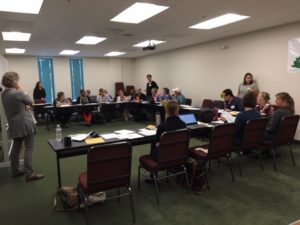By Stephanie Oelsligle Jordan, Local Food Program Manager
 Sustainable Solano’s Local Food Advisory Board had their third meeting on September 18, 2018. This group was formed to support Sustainable Solano’s Local Food initiative, launched in October 2017, with the help of a USDA Local Food Promotion Program planning grant (to see a full list of Advisory Board members, click here). The meeting was graciously hosted by Solano Community Foundation in Fairfield, CA. (Many thanks to all the SCF staff who helped with set-up, lights and technology!) The meeting began with an overview by Elena Karoulina, Executive Director of Sustainable Solano, who stated that our original project – examining the feasibility of Community Food Centers in Solano County’s seven cities – has outgrown itself. We have gone beyond the grant and are now envisioning a larger Solano County Local Food System, which will require an alliance among farmers and other stakeholders in the County.
Sustainable Solano’s Local Food Advisory Board had their third meeting on September 18, 2018. This group was formed to support Sustainable Solano’s Local Food initiative, launched in October 2017, with the help of a USDA Local Food Promotion Program planning grant (to see a full list of Advisory Board members, click here). The meeting was graciously hosted by Solano Community Foundation in Fairfield, CA. (Many thanks to all the SCF staff who helped with set-up, lights and technology!) The meeting began with an overview by Elena Karoulina, Executive Director of Sustainable Solano, who stated that our original project – examining the feasibility of Community Food Centers in Solano County’s seven cities – has outgrown itself. We have gone beyond the grant and are now envisioning a larger Solano County Local Food System, which will require an alliance among farmers and other stakeholders in the County.
The USDA working group studied existing demand segments in the County: charity food, retailers, prepared food businesses (i.e. restaurants), and institutional customers. To get a better sense of the supply – and really understand the needs of our local farmers – we reached out to over 50 local farmers in the County and conducted interviews. We have at least 12 farmers who are interested and willing to work on the vision of a sustainable, local food system in Solano County. Another area of study was successful business models, which we could use as a springboard for our own business plan. These groups included Ceres Community Project (Sebastopol), Three Stone Hearth (Berkeley), Fresh Approach (Concord), Capay Valley Farm Shop (Esparto) and Sierra Harvest (Nevada City).
Next, Kristin Kiesel of UC Davis provided a summary of the data collection process. Her team has been working to map out the supply in Solano County as accurately as possible. They used data from aggregated data sources, including the 2012 Ag Census and 2017 Solano Crop Report. Disaggregated data (farm-level data) was available via the interviews by the working group, and Certified Producer Certificates, which farmers acquire so they can sell at farmers markets in Solano County. Her next step was to see where these data sources all connect and to identify the overlap. Also, she and her team have formal requests in to the U.S. government, to acquire more detailed and current Census data. All of this data, and the resulting findings, will go into the feasibility study for the project.
Following this report was an open discussion around what type of business plan makes sense, for our next step. Simone Hardy, Solano County Agricultural Commissioner, also provided a brief history of Solano Grown, and where it stands now. Greg Morrison and myself summarized a 6-week pilot, where he organized logistics of getting local farm products to a kitchen, I cooked dinners (using local product availability as the base for my menus), and then those dinners got delivered to the participants.
Conclusions and findings are as follows:
- We need to strengthen the infrastructure of Solano’s agricultural community – perhaps in the form of a farmer’s collective/co-op.
- Farmers need the most assistance with marketing and distribution of products.
- We need to build community awareness and education around the value of local food, and the system that would support it.
- We are considering partnering with Economic Development departments in Solano’s cities.
- We should connect farmers to institutions first (as opposed to end consumers), to ensure consistent demand.
- We need sustainable relationships between farmers and their customers.
- We need strong partnerships with organizations and stakeholders, within the local food system.
- When considering food access, our best efforts will be in “farm to school” program implementation.
- Our planning process needs to include as diverse a group as possible (i.e. minority farmers, diverse community members).
The meeting ended with everyone listing on paper the values of a local food system. We will compile these values and let that guide us forward.

